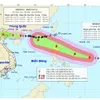Super typhoon Mangkhut to hit Vietnam on Sept. 17

At 1am of September 14, the storm’s eye was at about 15.4 degrees north and 127.7 degrees east, some 680km east-southeast of Luzon Island of the Philippines. It sustained winds of up to 200 – 220km per hour.
The NCHF predicted by 1am of September 15, Mangkhut will have moved west-northwest at a speed of about 20km per hour, staying at 17.3 degrees north and 123.1 degrees east in the eastern sea area of Luzon Island. It will retain the wind speed of 200 – 220km per hour.
From 1am of September 15 to 1am of September 16, the super typhoon will move northwest at about 25km per hour. Its centre will be at 19.1 degrees north and 117.7 degrees east, in the northeast of the East Sea and about 740km east of China’s Hainan Island. Maximum sustained wind speeds will be up to over 180km per hour.
From 1am of September 16 to 1am of September 17, it will move west-northwest at 25km per hour, with its centre located at 20.5 degrees north and 111.8 degrees east – in the eastern sea area of Hainan Island. Maximum wind speeds may reach 130 – 160km per hour, according to the NCHF.
Mangkhut is forecast to gradually abate when it lands in Hainan Island but remain very strong. It is likely to directly affect the Tonkin Gulf on September 16 and 17 and hit the mainland of Vietnam on September 17 and 18, causing downpours in the northern and northern central regions from September 17 to 19.
Meanwhile, Mangkhut is moving towards the Philippines and may hit this country’s mainland this weekend.
Philippine authorities said after blasting through the Northern Marianas Islands, it is speeding across the Pacific with winds that can gust as high as 255km per hour. It is predicted to make landfall in Luzon Island on September 15 morning.
Authorities said some 10 million people in the Philippines are in the storm's path, and thousands began evacuating in seaside areas of the northern tip of Luzon Island.
The country’s state weather service said Mangkhut will be the strongest typhoon so far this year, with sustained winds of 205km per hour.
The International Federation of Red Cross and Red Crescent Societies said it expects "substantial damage" on the Philippine path of Mangkhut.





